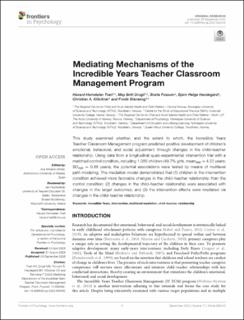| dc.contributor.author | Tveit, Håvard Horndalen | |
| dc.contributor.author | Drugli, May Britt | |
| dc.contributor.author | Fossum, Sturla | |
| dc.contributor.author | Handegård, Bjørn Helge | |
| dc.contributor.author | Kløckner, Christian | |
| dc.contributor.author | Stenseng, Frode | |
| dc.date.accessioned | 2021-03-11T15:05:42Z | |
| dc.date.available | 2021-03-11T15:05:42Z | |
| dc.date.created | 2020-09-01T09:48:48Z | |
| dc.date.issued | 2020 | |
| dc.identifier.citation | Frontiers in Psychology. 2020, 11 1-10. | en_US |
| dc.identifier.issn | 1664-1078 | |
| dc.identifier.uri | https://hdl.handle.net/11250/2732973 | |
| dc.description | Copyright © 2020 Tveit, Drugli, Fossum, Handegård, Klöckner and Stenseng. This is an open-access article distributed under the terms of the Creative Commons Attribution License (CC BY) | en_US |
| dc.description.abstract | This study examined whether, and the extent to which, the Incredible Years Teacher Classroom Management program predicted positive development of children’s emotional, behavioral, and social adjustment through changes in the child–teacher relationship. Using data from a longitudinal quasi-experimental intervention trial with a matched control condition, including 1,085 children (49.7% girls, meanage = 4.22 years; SDage = 0.88 years), the potential associations were tested by means of multilevel path modeling. The mediation model demonstrated that (1) children in the intervention condition achieved more favorable changes in the child–teacher relationship than the control condition; (2) changes in the child–teacher relationship were associated with changes in the target outcomes; and (3) the intervention effects were mediated via changes in the child–teacher relationship. | en_US |
| dc.language.iso | eng | en_US |
| dc.rights | Navngivelse 4.0 Internasjonal | * |
| dc.rights.uri | http://creativecommons.org/licenses/by/4.0/deed.no | * |
| dc.subject | Incredible Years | en_US |
| dc.subject | intervention | en_US |
| dc.subject | multilevel mediation | en_US |
| dc.subject | child–teacher | en_US |
| dc.subject | relationship | en_US |
| dc.title | Mediating Mechanisms of the Incredible Years Teacher Classroom Management Programme | en_US |
| dc.type | Peer reviewed | en_US |
| dc.type | Journal article | en_US |
| dc.description.version | publishedVersion | en_US |
| dc.source.pagenumber | 1-10 | en_US |
| dc.source.volume | 11 | en_US |
| dc.source.journal | Frontiers in Psychology | en_US |
| dc.identifier.doi | https://doi.org/10.3389/fpsyg.2020.555442 | |
| dc.identifier.cristin | 1826374 | |
| cristin.ispublished | true | |
| cristin.fulltext | original | |
| cristin.qualitycode | 2 | |

